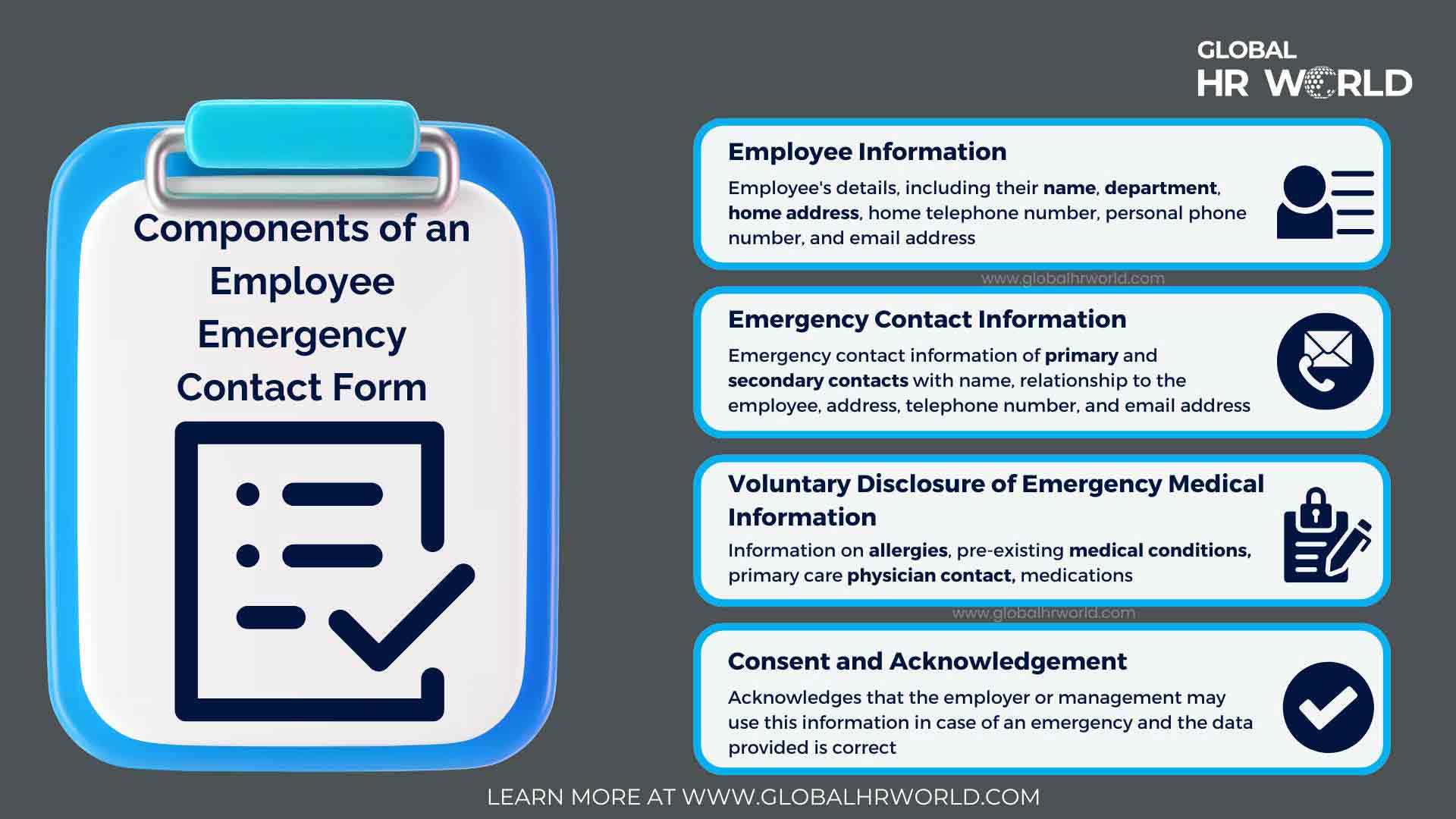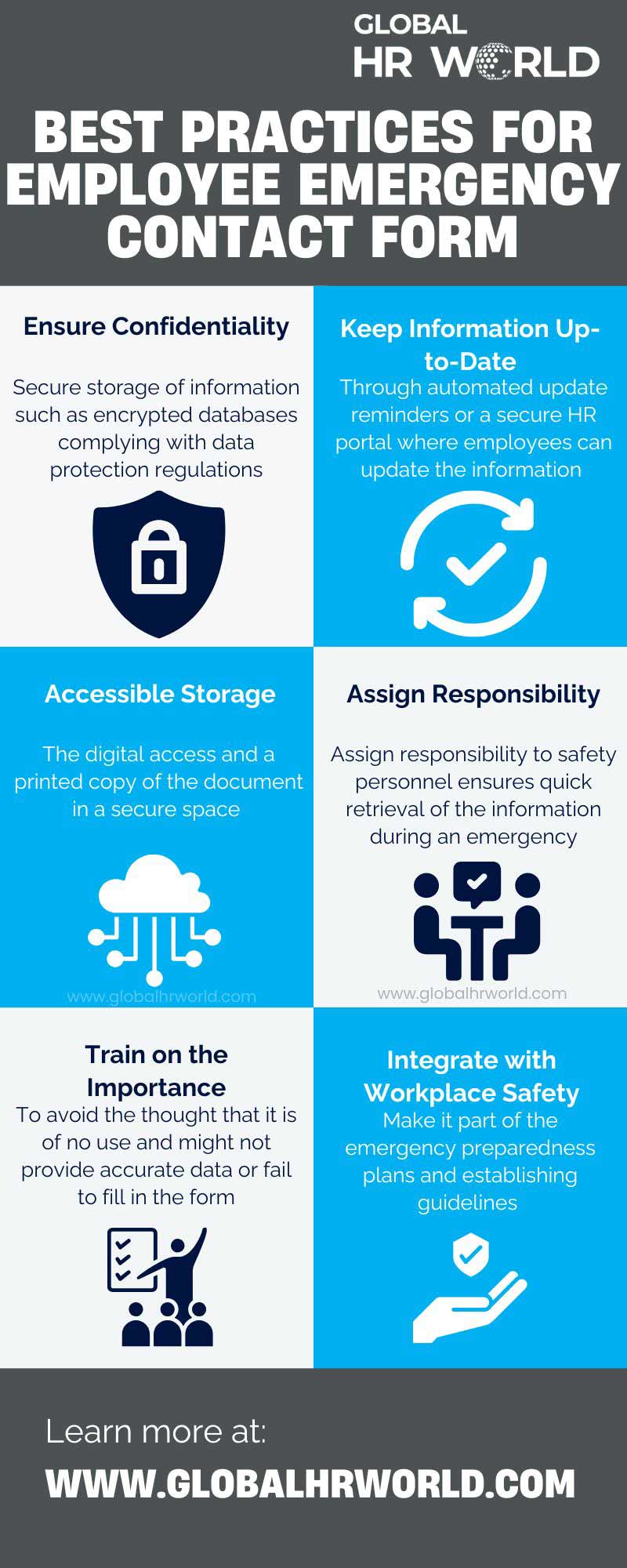Emergencies can happen anytime, and having the right information readily can make all the difference. An employee emergency contact form is a crucial document that provides timely assistance and every organization should collect and store the form to demonstrate its commitment to employee safety and well-being. Keep reading the entire article to gather insights on the employee emergency contact form, what information should be added, why every organization should maintain an employee emergency contact form, best practices, and the intervals for updation.
What is an Employee Emergency Contact Form?
An Employee Emergency Contact Form is a document that gathers the essential contact details of responsible individuals who could be contacted during an emergency. The responsible individuals include immediate relatives or friends who can respond quickly to the circumstances. The emergencies an employee faces can include workplace accidents or injuries, a medical emergency, or environmental changes.
This form is usually collected during the onboarding and employees are supposed to fill in the details of primary and secondary contacts along with reporting their medical conditions, if any. With HR managers holding access to the updated Employee Emergency Contact Form, an organization ensures handling challenging situations swiftly without any delay.
What Information Should be Included in the Employee Emergency Contact Form?
Every organization should possess a standard template with all the relevant information needed to help an employee in case of an emergency. The following data should be incorporated into an employee emergency contact form.

Employee Information
The employee’s details, including their name, department, home address, home telephone number, personal phone number, and email address.
Emergency Contact Information
The emergency contact information of primary and secondary contacts incorporating the contact’s name, relationship to the employee, home address, home telephone number, alternate telephone number, and email address needs to be provided.
Voluntary Disclosure of Emergency Medical Information
The employee can disclose (it’s usually optional) relevant medical details that may be critical in an emergency. This can include information on allergies, pre-existing medical conditions, primary care physician contact information, medications, or special medical information.
Consent and Acknowledgement
The employee confirms that the information provided is accurate and up to date. By checking the designated box, the employee acknowledges that the employer or management may use this information in case of an emergency and understands that it will be kept confidential in accordance with company policies and data protection regulations. This acknowledgment is duly signed by the employee as a formal declaration of consent.
Why Every Organization Should Maintain Employee Emergency Contact Form?
An Employee Emergency Contact Form is a vital necessity in organizations to protect their employees. Here are some of the reasons why organizations should maintain employee emergency contact forms.
Employee Safety
With immediate access to employees’ essential contact information that assists in emergencies, the form provides safety to the employees and the management can utilize the information to prepare for potential work hazards.
Legal Requirement
An Employee Emergency Contact Form is a legal requirement for the organization to ensure its compliance with workplace safety laws. Failure to take appropriate steps to protect employees results in legal consequences for the employer
Efficient Communication During Emergencies
In case of emergencies or crises, HR managers can easily retrieve the primary and secondary contact information and inform the situation to coordinate necessary care reducing panic and miscommunication. Furthermore, the details of the medical condition and the primary medical care physician ensure immediate action to protect the individual.
Workplace Preparedness
The Employee Emergency Contact Form is a critical component of an organization’s emergency preparedness plan enabling the leadership to emergencies including medical emergencies, natural calamities, workplace accidents, and security threats. This ensures appropriate medical assistance to the employees and enables organizations to offer business continuity.
Strong Workplace Culture
Maintaining the Emergency Employee Contact Form demonstrates the organization’s commitment to employee safety. Employees feel that they are safe and supported by their organizations and develop trust fostering a strong workplace culture.
What are the Best Practices for Employee Emergency Contact Form?
Although the Employee Emergency Contact form is a critical document that ensures workplace safety, employees often hesitate to provide necessary information as they fear data breaches or unauthorized access to personal data and a perception that it’s not necessary as they work in a low-risk office environment. To avoid this stigma implementing these best practices is essential.
Ensure Confidentiality
To manage employee information securely, organizations must ensure secure storage of information such as encrypted databases complying with data protection regulations. Moreover, ensure the communication channels as secure when communicating with the contacts.
Keep Information Up-to-Date
Keeping the information updated through automated update reminders or a secure HR portal where employees can update the information to ensure it is accurate and current.
Accessible Storage
Another best practice is to have the information readily accessible yet secure to avoid chaos during emergencies. In addition to the digital access, keep a printed copy of the document in a secure space to easily grab information during power outages or system failures associated with the emergency.
Assign Responsibility
The primary custodian of the data is HR Manager who is responsible for collecting and maintaining the information along with verifying the accuracy, validity, and security of the data. However, assigning responsibility to safety personnel ensures quick retrieval of the information during an emergency.
Train on the Importance of the Form
Employees disregard the importance of the Emergency Contact Form thinking it is of no use and might not provide accurate data or fail to fill in the form. Adopting the best practice of training employees on the importance of the form and affirming the document is confidential can address these concerns. When training the employees on the importance of the form, incorporating real-life or hypothetical workplace scenarios reaps the best outcomes.
Integrate with Workplace Safety
To ensure a quick and effective response during emergencies, integrating employee emergency contact forms with workplace safety is essential. This can be performed by making it part of the emergency preparedness plans and establishing guidelines on informing the emergency contacts.
How Often Should an Employee Emergency Contact Information Be Updated?
Although different organizations follow different periods for updating the Employee Emergency Contact Information, it is advisable to review and update the data at least once a year, during major life changes, or align with safety training exercises. Utilizing automated reminders that prompt employees to update their contact information contributes to effective updations.
Conclusion
To sum up, an Employee Emergency Contact Form gathers the essential contact details of responsible individuals who could be contacted during an emergency. The major information included in the document includes employee information, the details of primary and secondary contacts, voluntary disclosure of emergency medical information, and consent and acknowledgment. Organizations must maintain this form to ensure employee safety, adhere to legal compliance, promote efficient communication during emergencies, workplace preparedness, and a strong workplace culture.
HR managers should incorporate the best practices such as ensuring confidentiality, keeping information up-to-date, accessible storage, assigning responsibility, training on the importance of the form, and integrating it with workplace safety for effective responses in emergencies. It is advisable to review and update the data at least once a year, during major life changes, or align with safety training exercises. Organizations should maintain accurate and up-to-date Employee Emergency Contact Form to foster a culture of preparedness and care.
Infographic

Knowledge Check!
Frequently Asked Questions (FAQs)
What is an Employee Emergency Contact Form?
An Employee Emergency Contact Form is a document that gathers the essential contact details of responsible individuals who could be contacted during an emergency.
What Information Should be Included in the Employee Emergency Contact Form?
The major information included in the document includes employee information, the details of primary and secondary contacts, voluntary disclosure of emergency medical information, and consent and acknowledgment.
Why Every Organization Should Maintain Employee Emergency Contact Form?
Organizations must maintain this form to ensure employee safety, adhere to legal compliance, promote efficient communication during emergencies, workplace preparedness, and a strong workplace culture.



